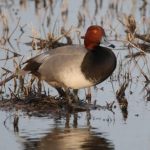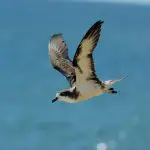Common Name: Hooded Merganser
Scientific Name: Lophodytes cucullatus| Size | Diet | Range in Hawaii | Status in Hawaii |
|---|---|---|---|
| 15 in. - 19 in. | small fish, amphibians, crustaceans, and aquatic insects | Oahu, the Big Island, Kaua'i, and Moloka'i | Least Concern |
The Hooded Merganser (Lophodytes cucullatus), a captivating waterfowl species known for its distinctive appearance and intriguing behaviors, has occasionally been spotted on the islands of Oahu, the Big Island, Kaua’i, and Moloka’i in Hawaii.
In this article, we delve into the fascinating world of the Hooded Merganser, exploring its unique characteristics, preferred habitats, and captivating courtship displays. These occasional sightings add a touch of excitement to the avian diversity found in the beautiful islands of Hawaii.
Hooded Merganser
Appearance
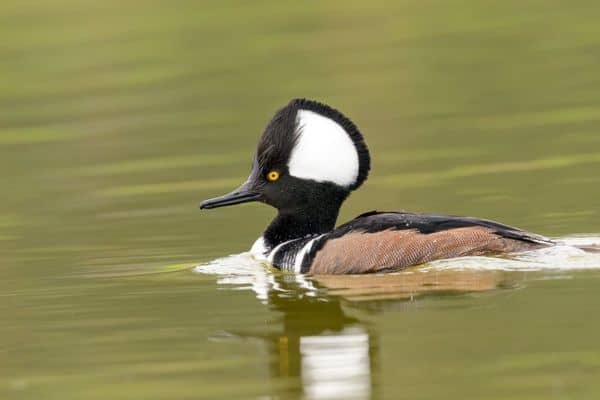
The Hooded Merganser is a striking waterfowl species known for its distinct and captivating appearance. The male Hooded Merganser features a black head with a large white crest, giving it a hooded appearance.
Its eyes are bright yellow, and its bill is long and slender. The male’s body is mostly black, with white patches on the sides and belly. In contrast, the female has a more subdued appearance, with a reddish-brown head and a grayish-brown body.
Both genders have slender body and a pointed tail. The Hooded Merganser measures approximately 15 to 19 inches (38 to 48 centimeters) in length.
Diet
The Hooded Merganser has a diverse and primarily carnivorous diet. It feeds on a variety of aquatic organisms, including small fish, amphibians, crustaceans, and aquatic insects. With its long, serrated bill, the Hooded Merganser is well-equipped for capturing and consuming its prey.
It often dives underwater to hunt, using its keen eyesight to spot its targets. This waterfowl species is an adept and agile swimmer, allowing it to pursue and capture its preferred food sources with ease.
Nesting
The Hooded Merganser exhibits interesting nesting behaviors. The female merganser selects a nest site typically located in a tree cavity or a natural cavity, often near water bodies such as lakes, rivers, or marshes. She lines the nest with down feathers to create a soft and insulating bed for the eggs.
Hooded Mergansers are cavity nesters, which means they rely on existing tree holes or nest boxes provided by conservation efforts. The female lays a clutch of around 9 to 12 eggs and incubates them for approximately 30 days.
Once the ducklings hatch, they leave the nest shortly after and follow the female to nearby water sources, where they learn to swim and forage under her guidance.
Behavior
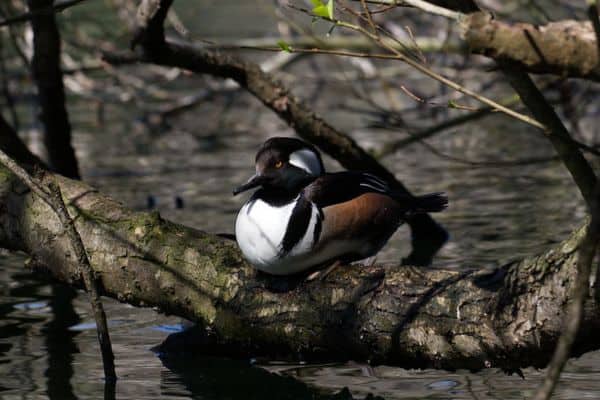
The Hooded Merganser showcases intriguing behaviors that make it a captivating waterfowl species to observe. These birds display remarkable diving and swimming abilities, frequently submerging themselves to hunt for prey.
With their streamlined bodies and agile movements, they navigate through the water with impressive speed and precision. Hooded Mergansers are recognized for their distinctive courtship displays, in which males elevate their crests and engage in intricate head movements to attract females.
They also demonstrate synchronized swimming, gracefully moving in synchronized formations. Outside of the breeding season, Hooded Mergansers can be spotted in small flocks, often mingling with other waterfowl species.
These birds are generally cautious, swiftly taking flight or diving underwater when they detect potential threats. The behavior of the Hooded Merganser exemplifies their adaptability to aquatic environments and their ability to communicate and interact with their counterparts.
Habitat
The Hooded Merganser is typically found in freshwater habitats across North America. They have a preference for forested wetlands, including swamps, marshes, and wooded ponds. These birds are often associated with areas that offer a combination of open water and dense vegetation, providing both hunting opportunities and suitable nesting sites.
Hooded Mergansers can also be seen in rivers, streams, and lakes, particularly those with an abundance of submerged vegetation where they can find food. Their habitat choice reflects their reliance on both water and forested areas, making them well-adapted to diverse wetland ecosystems.
Range
The Hooded Merganser, although not native to Hawaii, has been occasionally sighted in the islands, including Oahu, the Big Island, Kaua’i, and Moloka’i. However, it is important to note that these sightings are infrequent, and the species does not have an established population or breeding presence in Hawaii.
Conservation Status
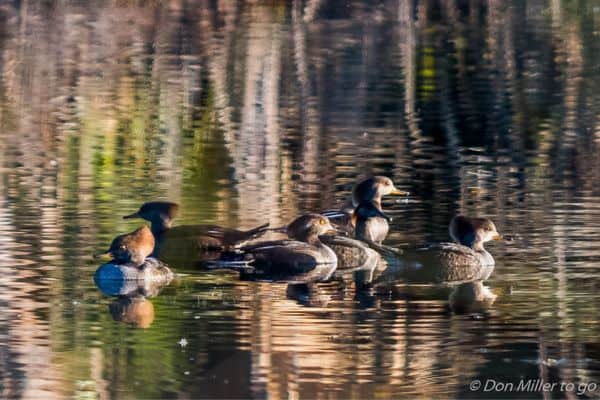
The Hooded Merganser is currently classified as a species of “Least Concern” according to the International Union for Conservation of Nature (IUCN). The overall population of Hooded Mergansers is considered stable, and they have a wide distribution across their native range in North America.
However, localized threats such as habitat loss, pollution, and disturbance to nesting sites can impact specific populations. Conservation efforts focus on preserving and restoring wetland habitats, as well as raising awareness about the importance of maintaining suitable breeding and foraging areas for this unique waterfowl species.
Interesting Facts
1. Unique Plumage
Male Hooded Mergansers possess an eye-catching black and white crest on their head, which can be erected or flattened depending on their mood or courtship display.
2. Skillful Diver
Hooded Mergansers are excellent divers, capable of diving underwater to search for their prey. With their streamlined bodies and webbed feet, they navigate through the water with agility and grace, catching fish, crustaceans, amphibians, and insects.
3. They are Tree Cavity Nester
Unlike many other ducks that nest on the ground, Hooded Mergansers are cavity nesters. They often choose tree cavities near water bodies as their nesting sites. The females line the nest with down feathers, creating a cozy and safe environment for their eggs.
4. Agile Flyers
Hooded Mergansers are skilled flyers with strong wings. They can take off from the water quickly and fly with speed and agility. Their flight is characterized by rapid wingbeats, allowing them to cover considerable distances and navigate through different habitats with ease.
Frequently Asked Questions
1. Can Hooded Mergansers fly?
Yes, Hooded Mergansers are agile flyers with strong wings, allowing them to take off quickly from the water and fly with speed and maneuverability.
2. Are Hooded Mergansers found in Hawaii?
While Hooded Mergansers are not native to Hawaii, occasional sightings of these birds have been reported on Oahu and the Big Island. However, they are not considered resident birds and their presence in Hawaii is not widespread.
3. Are Hooded Mergansers social birds?
While Hooded Mergansers are generally solitary birds, they can be found in small groups during the non-breeding season, often associating with other waterfowl species.
4. How fast can Hooded Mergansers fly?
Hooded Mergansers are capable of flying at impressive speeds, reaching velocities of up to 50 miles per hour (80 kilometers per hour). They are swift and agile flyers, enabling them to cover considerable distances during their migratory journeys.

